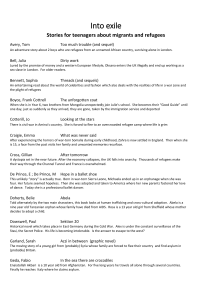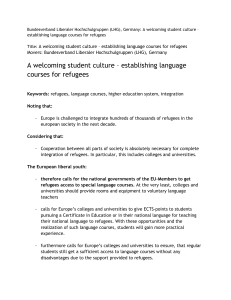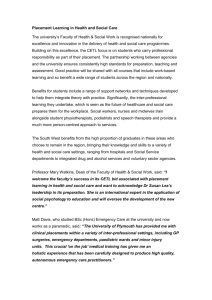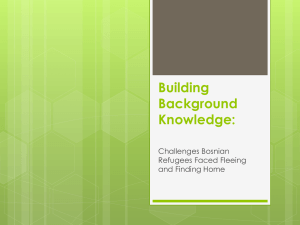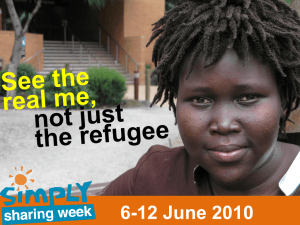Refugees: Who, Where, Why - Lancaster Central School District
advertisement
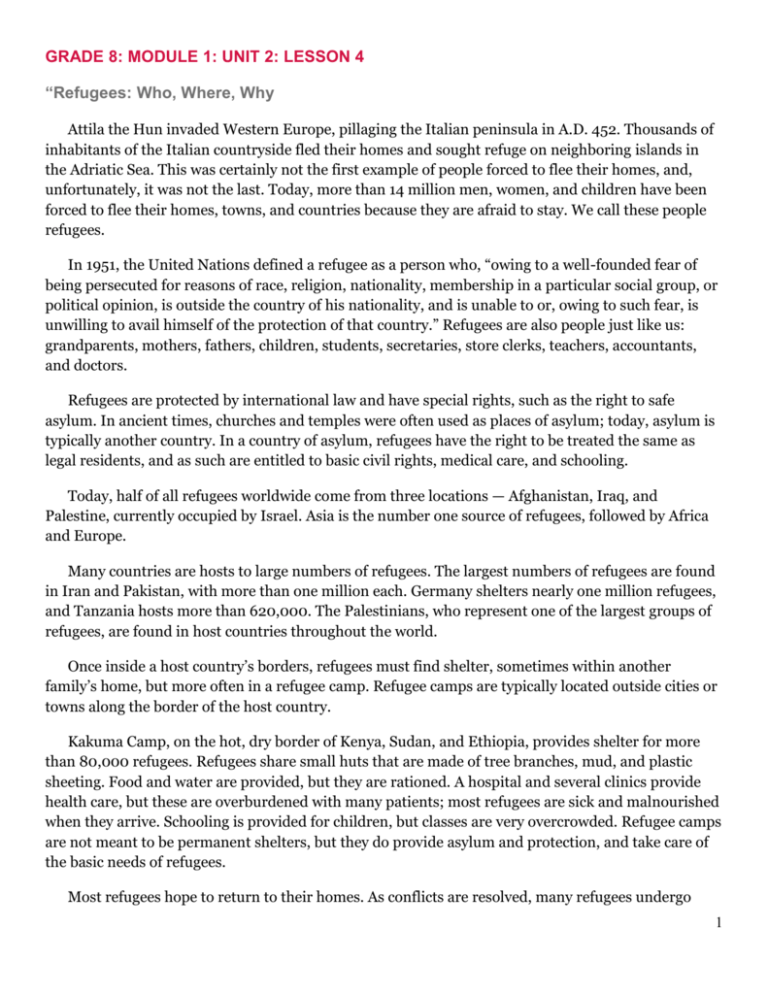
GRADE 8: MODULE 1: UNIT 2: LESSON 4 “Refugees: Who, Where, Why Attila the Hun invaded Western Europe, pillaging the Italian peninsula in A.D. 452. Thousands of inhabitants of the Italian countryside fled their homes and sought refuge on neighboring islands in the Adriatic Sea. This was certainly not the first example of people forced to flee their homes, and, unfortunately, it was not the last. Today, more than 14 million men, women, and children have been forced to flee their homes, towns, and countries because they are afraid to stay. We call these people refugees. In 1951, the United Nations defined a refugee as a person who, “owing to a well-founded fear of being persecuted for reasons of race, religion, nationality, membership in a particular social group, or political opinion, is outside the country of his nationality, and is unable to or, owing to such fear, is unwilling to avail himself of the protection of that country.” Refugees are also people just like us: grandparents, mothers, fathers, children, students, secretaries, store clerks, teachers, accountants, and doctors. Refugees are protected by international law and have special rights, such as the right to safe asylum. In ancient times, churches and temples were often used as places of asylum; today, asylum is typically another country. In a country of asylum, refugees have the right to be treated the same as legal residents, and as such are entitled to basic civil rights, medical care, and schooling. Today, half of all refugees worldwide come from three locations — Afghanistan, Iraq, and Palestine, currently occupied by Israel. Asia is the number one source of refugees, followed by Africa and Europe. Many countries are hosts to large numbers of refugees. The largest numbers of refugees are found in Iran and Pakistan, with more than one million each. Germany shelters nearly one million refugees, and Tanzania hosts more than 620,000. The Palestinians, who represent one of the largest groups of refugees, are found in host countries throughout the world. Once inside a host country’s borders, refugees must find shelter, sometimes within another family’s home, but more often in a refugee camp. Refugee camps are typically located outside cities or towns along the border of the host country. Kakuma Camp, on the hot, dry border of Kenya, Sudan, and Ethiopia, provides shelter for more than 80,000 refugees. Refugees share small huts that are made of tree branches, mud, and plastic sheeting. Food and water are provided, but they are rationed. A hospital and several clinics provide health care, but these are overburdened with many patients; most refugees are sick and malnourished when they arrive. Schooling is provided for children, but classes are very overcrowded. Refugee camps are not meant to be permanent shelters, but they do provide asylum and protection, and take care of the basic needs of refugees. Most refugees hope to return to their homes. As conflicts are resolved, many refugees undergo 1 repatriation. During the 1980s, civil war erupted in Central America, causing more than two million people to flee their homes. In 1987, a regional peace agreement was signed ending the war and allowing thousands of people to return to their homes. Some refugees cannot return home, nor can they stay in their country of asylum. They must resettle in a new country. Since World War II, millions of refugees have been successfully resettled in ten established resettlement countries, including Canada and the United States. The United States has traditionally been a sanctuary for refugees. One of the first groups of refugees to arrive were the Pilgrims. In 1620, the Mayflower sailed into what is now Plymouth harbor carrying refugees from England. They had fled to America because of religious persecution in their homeland. Since then, millions of refugees have resettled in the United States. From 1975 to 2001, more than two million refugees were offered resettlement. People become refugees for many reasons. The number one reason is war. Perceptions of unfairness, such as unequal treatment or denial of rights based on race, religion, economic status, or political thought, instigate war; so does unequal access to land, food, water, and other necessary resources. Another important trigger is the feeling of superiority over others; some individuals feel their system of belief, country, or ethnic background is superior to that of others. In 1991, Yugoslavia splintered into several independent states. One of these states, Bosnia, was an ethnic mix of Muslims, Serbians, and Croatians. The Serbians, who were predominantly Christian, decided that Muslims should not be allowed to live in their new country. They began an “ethnic cleansing” campaign, which killed thousands of innocent men, women, and children, and forced hundreds of thousands of people to seek refuge in neighboring countries. Others are forced to flee their countries because of natural disasters such as floods, fires, and drought, although they are not considered refugees by the United Nations. In January 2002, Mt. Nyiragongo in the Democratic Republic of the Congo erupted, sending tons of red-hot lava through the city of Goma. As buildings and villages burned, 400,000 people fled into neighboring Rwanda. In Ethiopia, crop failures and livestock loss caused by drought conditions over the last several years have caused widespread famine. Thousands have fled into neighboring countries in search of food and water. Since early times, large groups of people have been forced to leave their homelands because of persecution and the devastation of their lands. In today’s world, we have the knowledge and tools to seek solutions to some of these issues. We must also consider and respect the human rights of every man, woman, and child. It may seem like an enormous task to some, but it is one we can all achieve. 2 Persecuted means oppressed or harassed, especially because of race, religion, gender, sexual orientation, or beliefs. Repatriation is the process of returning to one’s country of birth, citizenship, or origin. Through Time — Refugees • 1950 The United Nations High Commissioner for Refugees (UNHCR) is set up to help the more than one million Europeans displaced after World War II. • 1956 Uprisings in Hungary force more than 200,000 people to become refugees. • 1959 Algeria fights for its independence and 200,000 people flee the country. • 1964 Rwanda, Mozambique, and Tanzania explode in conflicts for independence and thousands become refugees. • 1971 More than ten million Bengalis flee to India, as Bangladesh becomes a nation. • 1974 Nearly 400,000 refugees become homeless as the Greeks fight the Turks in Cyprus. • 1978 About three million Asians escape to neighboring countries, including Thailand and Malaysia, during conflicts throughout Indochina. • 1979 Six million Afghans flee their country. • 1980s Violence in Central America results in more than 300,000 refugees. In Africa, many Ethiopians try to escape drought and war in Sudan. • 1990s During the Gulf War, 1.5 million Iraqi Kurds become refugees. Civil war in West Africa causes 800,000 West Africans to flee their homes. War in the Balkans forces thousands to leave their homes as Yugoslavia breaks apart. • 1991 Fighting in Somalia forces about 750,000 Somalis to seek shelter in Ethiopia. • 1992 More than 1.5 million refugees return to their homes in Mozambique as part of repatriation program. • 1993 Thousands of Cambodian refugees return home as part of a repatriation program. • 1994 Widespread killing in Rwanda sends thousands to neighboring countries. • 1999 More than one million people from Kosovo are forced to leave their homes. • 2001 Thousands of people flee Afghanistan 3


